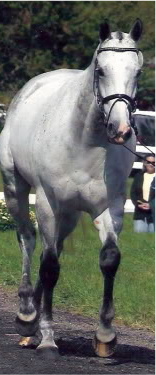
Do you ever stare in awe at the sleek shiny horses, the glistening brass, perfect braids, and dazzling white marks at a CCI trot up? Do you ever wonder how they get that way? (LOTS of hard work is the correct answer!) Each Sunday morning we will bring you a little insider info on how the big-time grooms manage an upper level event horse. Feel free to email or comment with specific grooming questions if you have a topic in mind!
Previous entries:
A Close Shave
Shining, Shimmering, Splendid

An old hunter groom once told me in a Pony Club lesson, “The poorest kid can have the best-looking horse in the class.” We looked at her quizzically. She tossed aside the fancy goat-hair brushes, the European polishing cloths, bottles of Showsheen, and held up her empty palms. “This is all you need,” she said. Elbow grease is the surest thing for a healthy shine on your horse’s coat; even rubbing with your bare hands is an excellent way to distribute natural oils and stimulate the skin. Nothing looks quite as glamorous as a glistening coat, that iridescent gleam (or “bloom”) that is the result of hours of daily effort. No amount of Showsheen or shampoo can replicate it!
I’m sure you all know how to brush a horse– curry first, dandy brush, etc. I won’t waste your time reciting the words in the Pony Club D Manual. But I will stress that putting in the daily time makes the best shine. Don’t skimp on your currying, even if the horse isn’t that dirty– it’s the heat and friction that does the work, not simply removing mud. Sensitive horse? Use a soft jelly-scrubber or nubby mitt, whatever the horse will tolerate. Concentrate on muscled areas of the neck, shoulder, back, and rump– avoid tender flanks and belly if it excessively irritates the animal. Use massage-like motions, moving in small movements with the skin and not just roughly against the hair.
When you’re done currying and brushing the dust off, follow up with hot-toweling. This is the old-fashioned secret employed by most top barns in both the show world, and for the Thoroughbred sales ring. Get a small bucket (about 8qt size) of very hot water– it shouldn’t be scalding, but it should be more than simply “very warm.” Add a small squeeze of dish soap (or baby oil, if dry-skinned). Dunk a small hand-towel in the hot water, and wring it out very thoroughly. Start at the horse’s face. Using curry-like motions, scrub the horse from head to toe with your (slightly) damp rag, getting down to the skin. The idea is to steam-clean the horse, not get him soaking wet. (Don’t worry if he ends up a little too wet the first few times– it happens to all of us as we’re learning! Wring out that rag really well!!) Dunk the rag back in the water whenever it gets cold or dirty– usually after one horse quarter. If your horse is very dirty, change out the hot water between sides. Scrub at any stains, especially on white areas–daily attention makes for an overall cleaner horse for special occasions.
The horse should be dry by the time you finish the other side. Go over the horse with a short-bristled body brush to lay the hair properly, using brisk, firm strokes to stimulate the warm skin. Hang on to your damp rag, and use it to whisk across your body brush (instead of a curry) to clean it every few strokes. A horse who is hot-toweled every day rarely needs a bath except for shows (grays may be excluded!). Keeping the skin clean helps avoid fungal infections, as well as creating that beautiful shine. Hot-toweling is especially important for clipped horses whose coats may be a little rough or harsh.
Despite all the benefits of hot-toweling, I do tend to skip the procedure in the winter on horses with very shaggy, woolly coats. It is almost impossible to get to the skin without getting the hair too wet; and in 20-degrees, wet hair is the last thing I want to create! For the long-haired horse, I spend plenty of time currying (usually with force, to get through the fluff), and occasionally vacuum if the mud is really caked on.
Another cheap trick is to thoroughly rub your horse after you ride. It sounds incredibly simple, but just take an extra 5 minutes after you untack, and use a rag (or bare hands!) over the neck, shoulders, chest, back, and haunches. Horses learn to love the massage, and rubbing the warm muscles really brings out the oils of the coat. Keep at it for a few weeks, and the coat will be noticeably softer. If your horse is only slightly sweaty, don’t be lazy and head to the wash stall– get that rag and go to work! Even when you DO have to hose off, take a little extra time to dry the body (not just legs) with a towel. The horse doesn’t have to be DRY…but just a little rubbing makes a difference. I know our lives are busy and time is short, but I promise if you put in the daily effort you will see the reward!
NOTE: Of course, a quality coat starts on the inside. Proper nutrition and good feed is important. Adding oil, flax, or rice bran, or specific vitamin supplements, are some ways to help “feed” for a shiny coat. However, good grass (and/or hay) supplies most of the horse’s vitamin requirements– most commercial grains are also loaded with extra goodies, too, so supplementation is often unnecessary. Consult an equine nutritionist if you believe your horse needs any feed additives.



















